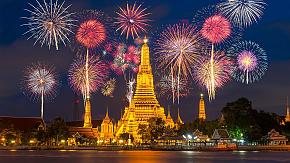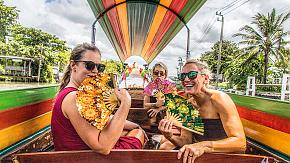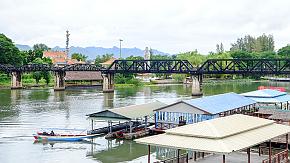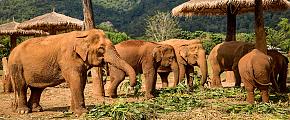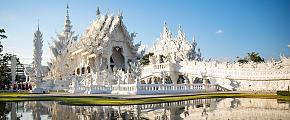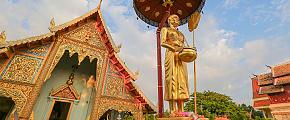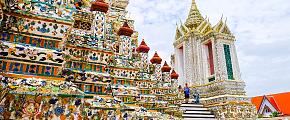What to Eat in Thailand: Thai Food and Culture
As long as I live, and I've been practicing longevity for years, I will never forget my first meal in Thailand. It was a long time ago, somewhere in Bangkok's Phra Nakhon District. I'd just flown in from China and was hungry. I was walking along a dusty street and spotted a woman cooking on the sidewalk, and behind her were dozens of tables of what looked to me like happy and local diners.
I didn't and still don't speak a word of Thai apart from basic greetings, but my need for food prevailed and I pointed to a fish, perhaps a grouper, lying beside her wok waiting to be sacrificed for the peckish foreigner. I don't know what she did but what she rapidly served me was and is still one of the most memorable meals of my life!
Many years later, I went back to where I found her but her spot had turned into a bunch of uninteresting western fast food restaurants, KFC and a Domino's Pizza place. Sad.
Ten years later, I spent some time on a beautiful Thai island, which I'm not going to identify, but only because it is now a closed nature reserve and you can't go. I wish you could. I wish I could. It certainly had nature. One morning, I was sitting outside my rented bungalow on the beach, enjoying my morning coffee, when the biggest snake I've ever seen slid along the sand, slid up the wall of my bungalow, slid across the roof, and slid into the forest behind. My partner, who was still asleep in the bungalow, is terrified of snakes. If she sees even a picture of one in a newspaper she runs off screaming. To this day, I have never told her what I saw.
But I'm not here to discuss ophidiophobia. Later that day, we ventured to the only restaurant on the island. This beachside restaurant had two staff whom I'm guessing were father and son. Father looked after the cooking while son seemed to do what you might describe as "front of house", although that was just a bunch of plastic tables and chairs stuck in the sand. Soon, we discovered he had another important function in the family business.
He came out menu-less and asked what we would like. Partner wanted crab.
"Do you have crab?"
"Yes. Of course. Please wait!"
Moments later, we saw him scurrying along the beach while father served us some snacks, none of which I remember. Eventually, the son returned, dripping wet but clutching a huge, still twitching crab which he handed to father.
A lot quicker than that snake crawled across our bungalow, we were served the best crab dish I have ever had the deep joy to insert into my mouth. Obviously, it was fresh having just been yanked out of the sea, but had been enhanced by Thai ingredients such as lemongrass, galangal, kaffir lime leaf and unidentified other ingredients. It surpassed my first Thai meal and that is a sentence I never thought I would write.
Despite never having been colonized like every other country in SE Asia, Thailand has not been shy to absorb influences from its neighbors. Or from further away in India, China, Europe or even the Americas. Just as it is impossible to imagine Italian food without tomatoes, it is equally impossible to imagine Thai food without chili peppers, yet these originated in Central America. They were introduced to Thailand in the 16th and 17th centuries by Spanish and Portuguese traders. I often wonder what Thai people ate in the 15th century! Other imports from the Americas include Thai staples such as cashews, corn, cilantro, papaya, pea eggplants, peanuts, pineapple, pumpkin, and tomatoes.
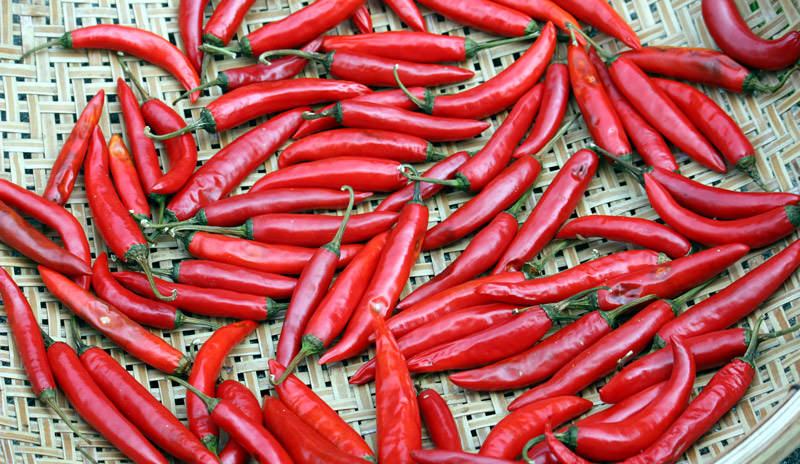 Chilies
Chilies
Thai cuisine (อาหารไทย ahan thai) can be approximately separated into four distinct regions, although food from each region is available in all the others, too.
Northern and Isan Cuisine
I've put these two together as, although they are distinct geographically, for the most part, they share a common cuisine with only minimal differences.
Northern Thai Cuisine (อาหารล้านนา ahan Lanna), also known as Lanna Cuisine, refers to that of the cool, forested, mountainous area in the north of the country bordering Myanmar / Burma to the north and west and Laos to the east. This area is populated mainly by hill tribes of various ethnic groups. The main city of Northern Thailand and a very popular tourist destination is Chiang Mai (เชียงใหม่).
Isan Cuisine (อาหารอีสาน ahan Isan) refers to that of north-eastern Thailand. This less visited area is mainly on the Khorat Plateau and has a generally more arid climate than its neighbor. Bordered to the east by Laos and to the south by Cambodia, Isan culture is heavily influenced by both, but much more so by Laos. In fact, the majority of its population are ethnically Lao, although there are sizeable Vietnamese, and Khmer communities as well as those of the Mon, Cham, and other Tai groups.
Both Northern Thai and Isan cuisines make extensive use of sticky rice (ข้าวเหนียว khao niao), which is rolled by the right hand into small balls which are then dipped into side dishes and eaten.
A well-known dish is larb (ลาบ, also spelled laab, laap and other variations). This meat salad dish is originally from Laos and Isan follows the Lao model by mixing the ground/minced meat (chicken, duck, beef, pork or fish) with chili peppers, fish sauce (น้ำปลา nam pla), paduek (ปลาร้า pla ra, another type of fermented fish condiment from Laos), lime juice, roasted ground rice and herbs, especially mint. The meat may be raw (larb dip) or cooked (larb suk); I recommend the latter, as raw meat can harbor parasites.
This is one place where Lanna cuisine differs from the Isan version. Lanna larb does not contain any of the souring agents (fish sauces or lime juice), but instead shows a Chinese influence by using spices such as cumin, cloves, long pepper, star anise, Sichuan peppercorns and cinnamon, etc.
Som Tam (ส้มตำ), the famous spicy green papaya salad is also of Laotian origin and was introduced to Thailand via Isan. It is now ubiquitous. Som tam is usually served with sticky rice, but there is now a kind of fashion for having it with rice noodles instead. Like all great cuisines, Thai cuisine doesn't stand still.
Kai Yang (ไก่ย่าง), or Lao grilled chicken is often served with som tam and sticky rice. Sometimes falsely described as Thai grilled chicken on western Thai restaurant menus, this dish consists of a butterflied chicken marinated in fish sauce with garlic, turmeric, coriander/cilantro root, and white pepper. Depending on the chef, soy sauce, hoisin sauce, shallots, coriander seeds, lemongrass, chili, ginger, and vinegar may also be employed.
Back in Chiang Mai, you can find Khao Soi (ข้าวซอย), the local favourite. The dish has an interesting origin. It originated with the Chin Ho (จีนฮ่อ; Chinese: Qín huò) people, a group of Han and Muslim Hui people from China's Yunnan province who for various reasons settled in Burma and Northern Thailand in the late 19th and early 20th centuries. The dish they took with them and adapted to local conditions is a soupy noodle dish with crisp fried egg noodles and soft, boiled egg noodles with meat, pickled mustard greens, shallots, lime, and chilies, in coconut juice. It is similar to a yellow or massaman curry, but more soup-like. Influenced by Chinese Muslim cuisine, khao soi meat would tend to be chicken or beef, rather than pork.
Finally, before we head south one last feature of Lanna and Isan cuisine must be mentioned. They both have a predilection for eating insects, to the point that it has been claimed the area is the human insectivore center of the planet! It seems that this began out of necessity in times of hardship and famine, but the locals developed a taste for the bugs and continued wolfing them down in better times.
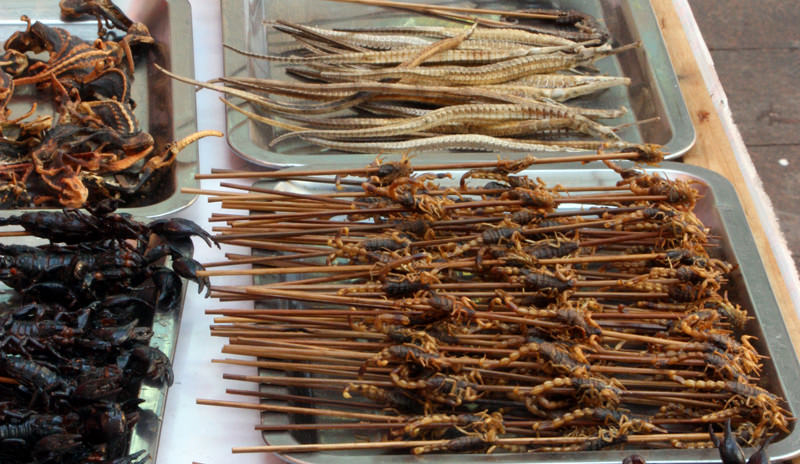 Fried insects
Fried insects
Crickets are the most popular, to the point that there are around 20,000 cricket farms in Thailand. Crickets are followed by grasshoppers, bee larvae, silkworms, and ant eggs, termites, bamboo worms, etc. Most of these are deep-fried and dressed lavishly in chili. They have very little taste and remind me of chili-flavoured popcorn. Yes, I've eaten some of them!
Maeng Da Na (แมงดานา), a type of giant water bug (Lethocerus indicus), also widely available, is said to taste like a particularly ripe version of an extremely strong blue cheese. An extract from the bugs is also used to make nam phrik malaeng da, a chili sauce used as a condiment. I've never eaten them, although I have seen them. Maybe next time.
Central Thai Cuisine
Central Thailand is the area surrounding the capital Bangkok and extending east to the border with Cambodia, and west to Myanmar. Its southern part includes the land on the Gulf of Thailand. This is a flat, wet rice-producing area and is where many of Thai cuisine's best known dishes originated. For the purposes of this article, I am going to exclude Bangkok itself, as its cuisine needs to be considered separately.
Central Thai cuisine (ahan Phak Klang อาหารภาคกลาง) has been heavily influenced by Chinese cuisine, both in terms of ingredients such as tofu, but also in its use of Chinese cooking techniques, particularly stir-frying. Incidentally, Thai people normally eat using a spoon and fork. The fork is used to push the food onto the spoon and the food then is eaten from there. Chopsticks are only usually used for eating soupy noodle dishes or in Chinese restaurants, of course.
Central Thailand is home to one of the world's best-loved soups, Tom yum or tom yam (ต้มยำ). This hot and sour soup comes in many varieties and consists of meat with aromatic herbs and spices such as lemongrass, kaffir lime leaves, galangal, lime juice, fish sauce, and red chili peppers which are ground together and fried. Tom yum paste is produced commercially and sold around the world, but in Thailand is more likely to be freshly prepared. Meats used can be chicken, beef or pork, but the most popular with visitors is tom yam goong (ต้มยำกุ้ง), made with prawns.
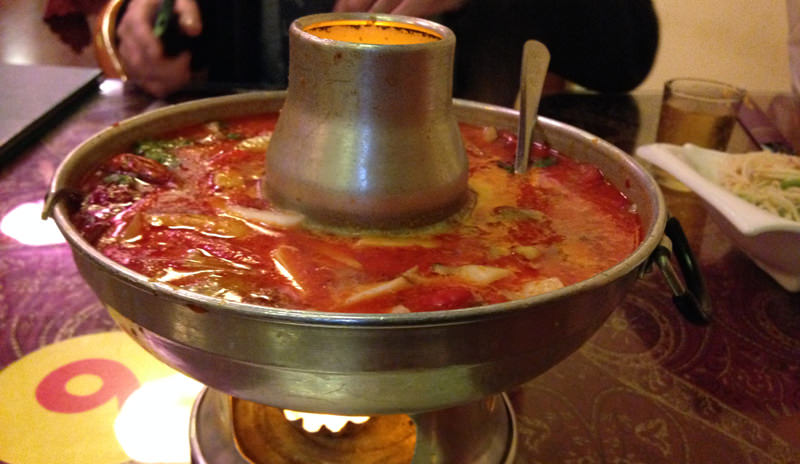 Tom Yam Goong
Tom Yam Goong
Also, a feature of Central Thai cuisine are the two well-known curries. Green curry (kaeng khiao wan แกงเขียวหวาน) and red curry (kaeng phet แกงเผ็ด). Each curry gets its color from the type of chilies used in preparing the curry paste. The curry pastes use chilies, shallots, garlic, galangal, lemongrass, kaffir lime peel, coriander roots (cilantro), cumin seeds, white peppercorns, and shrimp paste, which are traditionally pounded together using a mortar and pestle. Both also feature coconut milk (กะทิ), which is used in many Central Thai dishes.
Another feature of Central Thai cuisine is the use of Thai holy basil (กะเพรา kaphrao). This should not be confused with Thai basil or Thai lemon basil. A lot of basils in Thailand. To confuse things further, holy basil comes in two varieties "red" and "white". The red has a stronger flavor whereas the white pairs well with seafood. A very popular series of dishes is known simply as phat kaphrao (ผัดกะเพรา), which is meat stir-fried Chinese style with holy basil and garlic. It is served with Thai jasmine rice and often topped with a fried egg. The dish is usually seasoned with soy sauce, Thai fish sauce, oyster sauce, sugar, and bird's eye chilies, again showing a Chinese influence.
Bangkok Cuisine
As the city has the most international visitors in the world, it will come as no surprise to learn that Bangkok has a highly developed restaurant culture, involving all the cuisines of the world. It has four two-starred Michelin restaurants (none of them Thai) and 22 one-star restaurants, 14 of which are Thai places. In addition, all the global high street chain restaurants and fast food places are here.
Of course, the local food is heavily dominated by Central Thai cuisine, but every corner of Thailand and beyond is also represented. Bangkok has a large Chinatown and a sizeable Indian community meaning their cuisines are also available.
But what Bangkok is best known for is its street food. It is considered by many to be the Street Food Capital of the world. In fact, one of those one-star Michelin places is Jay Fai's street food shack. According to Michelin it "is a place that both taxi drivers and foodies wax lyrical about and it's easy to see why. Wearing her signature goggles, the local legend that is Jay Fai continues what her father started 70 years ago and makes crab omelettes, crab curries and dry congee." If you fancy Michelin-starred street food you can find her at 327 Samran Rat Intersection, Bangkok. Tel: +66 2 223 9384. She is open daily from 1:30 pm to 1:30 am the next morning.
Every dish yet invented in Thailand is probably to be found somewhere on Bangkok's streets. Some vendors specialize in just one dish; others may have more. Very popular is Pad Thai (ผัดไทย), which simply means Thai stir-fry and consists of rice noodles traditionally stir-fried with eggs and tofu, flavored with tamarind, fish sauce, dried shrimp, shallots, garlic chilies, and sugar. It is usually served with wedges of lime. Depending on the whim of the vendor it may also contain various vegetables or have the tofu substituted by chicken or seafood.
Isan Som tam (green papaya salad) is also common on Bangkok street food stalls, usually with sticky rice and grilled chicken as mentioned above.
Although street food is to be found all over the city, Yaowarat Road (ถนนเยาวราช Thanon Yaowarat) in Bangkok's Chinatown turns into a huge street food venue in the evenings, drawing visitors and locals alike.
Organized street food tours, either individual or group tours are widely available in Bangkok and other major tourist destinations, as are Thai cooking lessons.
Southern Thai Cuisine
Southern Thailand stretches from the Kra Isthmus, Thailand's narrowest point, down to the border with Malaysia. It is a popular destination, being where you find Phuket and many of the more famous Thai islands so beloved by travelers - Ko Samui, Ko Pha Ngan, Ko Tao, etc. With the Andaman Sea to the west and the South China Sea to the east, it will come as no surprise that seafood features a lot in its cuisine.
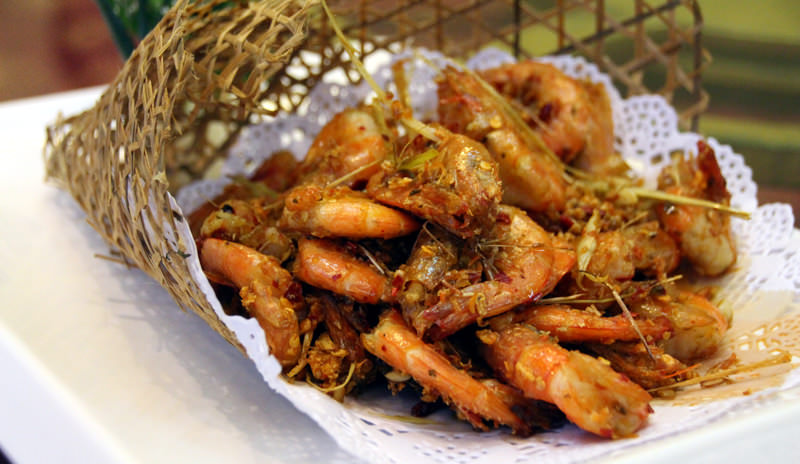 Thai fried shrimp
Thai fried shrimp
Again there are multiple influences on Southern Thai cuisine (อาหารภาคใต้ Ahan Phak Tai), including Muslim and Hindu influences. The latter can be seen in Kaeng matsaman (แกงมัสมั่น), well known in English as Massaman curry. This Indian-style curry, usually beef but occasionally chicken, uses roasted Indian spices such as cloves, coriander seeds, star anise, cumin, bay leaves, nutmeg, and mace which are absent from other Thai curries.
The Muslim influence appears in the popular dish, Khao Mok, a Southern Thai Muslim version of biryani, usually served with chicken, but beef is sometimes substituted. Satay (สะเต๊ะ sate) or grilled meat in a peanut sauce originated in Indonesia but is hugely popular across Thailand as a street food. It is also often served on Southern Thailand's beaches and in night markets.
Vegetarian Thailand
Vegetarian food can be hard to find in Thailand, especially away from the major tourist spots. Shrimp paste and fish sauce are used in most dishes, but not necessarily advertised. However, vegetarian food is available in some special restaurants bearing yellow signs with red Thai script reading เจ che or อาหารเจ ahan che, meaning "vegetarian" or "vegetarian cuisine".
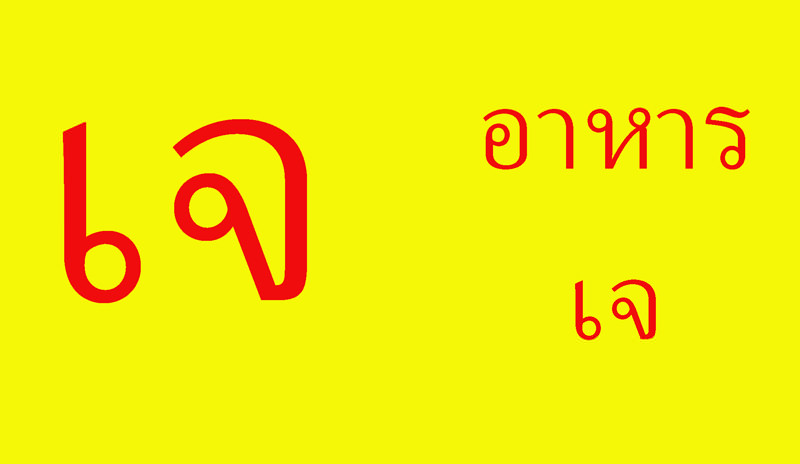 Signs for vegetarian food
Signs for vegetarian food
Fruit
Fresh fruit is hugely important in Thai cuisine. It is commonly served at the end of a meal and is incorporated into many savory dishes. Markets routinely offer such delights as papaya, several varieties of mango, longan, several types of banana, pomelo, mangosteen, rambutan, pineapples, lychees, Burmese grapes, and of course, durian.
Pineapples are paired with fish or duck in curries, jackfruit is used as a meat substitute in dishes, and beef and mango with fish sauce is one of my personal Thai favorites - the fish sauce melding with the mango gives a sweet and sour taste.
Drinks
Popular drinks in Thailand include iced tea (ชาเย็น cha yen) made from strong black tea and served with condensed milk and sugar, poured over ice and topped with evaporated milk. Iced coffee called oliang (โอเลี้ยง) is black coffee served with brown sugar, cardamom, corn, soybeans, rice, and sesame seeds.
Krating Daeng (กระทิงแดง; literally Red Bull) is popular and was the origin of Red Bull as sold in the West.
Beer is widely available, with two brands dominating. Chang (Elephant) Beer and Singha (Lion) Beer as is Mekong whisky and SangSom (แสงโสม), a Thai sugarcane rum.
Most world-popular soft and hard drinks are also available.
I hope this may have whetted your appetite for Thailand. Of course, I have merely scratched the surface of what is available in this beautiful country. Please remember that Odynovo's expert travel consultants can organize a complete itinerary to your specific needs and preferences. All you have to do is to tell them where you want to go and what you want to see and do and they will get back to you within 24 hours. This can be for Thailand or any of over 30 other exciting destinations.
What Our Clients Say
Explore the latest verified reviews of Odynovo's travel services on Tripadvisor, Google, Trustpilot, Product Review and more trusted platforms.

